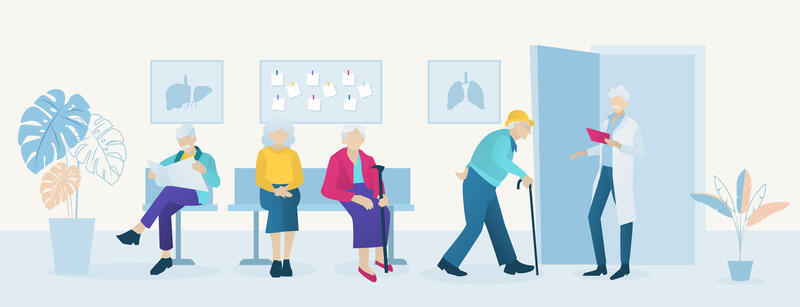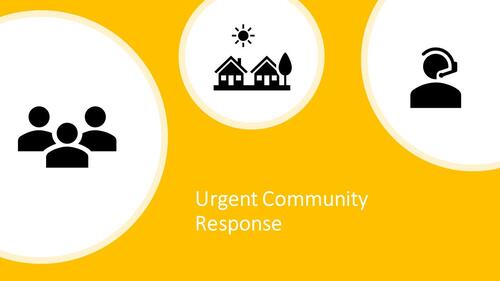NHS England commissioned the Strategy Unit at Midlands and Lancashire CSU and Partners Ipsos UK to conduct a multi-year, two-part evaluation of 2-hour Urgent Community Response (UCR). This national evaluation is the first of its kind to try to demonstrate the impact of an urgent at-home care service and will build evidence of what works best.
This initial phase of the evaluation includes a process evaluation and report and an economic modelling tool (to be published shortly), which are the key outputs from the first year and a half of the evaluation.
The final phase of the evaluation will be published in spring 2024 and include: key learnings from implementing UCR; proposals for policy changes to support Integrated Care Boards to understand what works best; an updated economic model; and an impact evaluation, which will focus on how UCR has met the needs of individuals and prevented further clinical deterioration as well as UCR’s impact on Urgent and Emergency Care.
Background on UCR and the national evaluation
The 2-hour urgent community response (UCR) standard requires all Integrated Care Systems (ICSs) to assess, treat and support people aged over 18 experiencing health and/or social care crises in the place they call home, including care homes, who are at risk of hospital admission. The service has been implemented across England since the first UCR ‘accelerator’ sites in 2020. Since April 2022, each ICS has been required to provide a consistent service from 8am-8pm, seven days a week across its full geography.
UCR is central to the NHS Long Term Plan ambition to provide the right care, at the right time, to people closer to home – and remains a core element of strategies to manage winter pressures, recover from COVID-19 and further shift resources to home and community-based services.
As set out in 2023/24 System Planning guidance, providers have been asked to increase referrals into UCR services, which should respond to the following nine clinical conditions, at a minimum:
The national evaluation of UCR is working with seven case study sites, selected to reflect a range of contexts and delivery models, to explore what works and provide learning for implementation across England. There is a process (qualitative) strand developing a narrative of the different approaches across the different stakeholders involved and an impact (quantitative) strand that will establish the difference the service makes on admissions.
Despite UCR being implemented in every ICS in England, variation remains between how different clinical conditions are responded to and how local teams establish their service model. Part of this variation is because the seven sites that were evaluated built their UCR service from existing provision, which differed from site to site. This is expected in a relatively new service, which requires extensive joint working across service and organisational boundaries. The national evaluation will support an understanding of what works best within certain types of settings.
Year one evaluation report
The first report from the national evaluation of the standard for NHS England draws on findings from over 100 qualitative interviews with senior leaders, managers and front-line staff. It provides an overview of the seven different case study models and learning from their development and delivery to August 2022, with recommendations for ICS leaders and NHS England. Findings are focused on operational learning; key benefits and challenges for patients, carers, staff and the wider healthcare system; and recommendations for system leaders.
Key findings include:
- Participating sites support the 2-hour waiting time standard for UCR and operating service model due to its perceived benefits in preventing deterioration among patients, reducing pressures on other health services, providing care in the community and enhancing cross-system working.
- The sites took different approaches to the way they set up their teams, data collection and use of resources to deliver at-home care within a two-hour timeframe. Rather than creating new UCR teams from scratch, the majority of sites worked to develop UCR services from existing teams, sometimes spanning multiple providers, and built on existing resources. This required partnership working across health and care to establish their UCR offer.
- The physical co-location of teams with other services and having weekly discussions to escalate cases was highlighted as a key facilitator of an integrated service. This enabled joint-working and the ability to build better relationships among staff, which resulted in improved communication and decision-making.
- Key areas in which sites have gone further than the national guidance include:
- Workforce and development (for example, unique or expanded job roles and duties or the introduction of specific UCR leadership roles and portfolios)
- Introduction of new technical resources, such as bespoke fully stocked service vehicles
- Investment in technological solutions for tracking available staff with appropriate skills to meet patient needs, enabling remote working and information sharing between providers
"[The 2-hour UCR team] were very well-prepared and they knew exactly what they were doing.” West Kent | Carer
- The most common areas identified for improvement include:
- Strengthening links with 111/999 services and working with virtual wards
- Developing a consistent system-wide model at scale
- Improving data quality in order to document progress on key performance measures
The evaluation team are continuing to work with the seven case study sites in 2023 as well as other providers as required to explore how provision has developed since the beginning of the evaluation. A quantitative impact evaluation will also be finalised by the end of the 2023/24 financial year.
“They treated me as a human being …experts in care and going above and beyond for me. They stayed with me to make sure I received the right medication for my needs.” MSE | Patient
Economic modelling tool
The team have developed an economic modelling tool that can help system planners and analysts understand the impact of UCR on finance and service-level activity, to support pathway modelling. It is accompanied by a user guide and five how-to videos.
The model is based on a set of assumptions, using local and national figures, and compares UCR activity against a situation where there is no UCR service of any kind.
The modelling tool and resources will be available here soon.
CC BY-NC-ND 4.0

This work is licensed under a Creative Commons Attribution-NonCommercial-NoDerivatives 4.0 International License.

